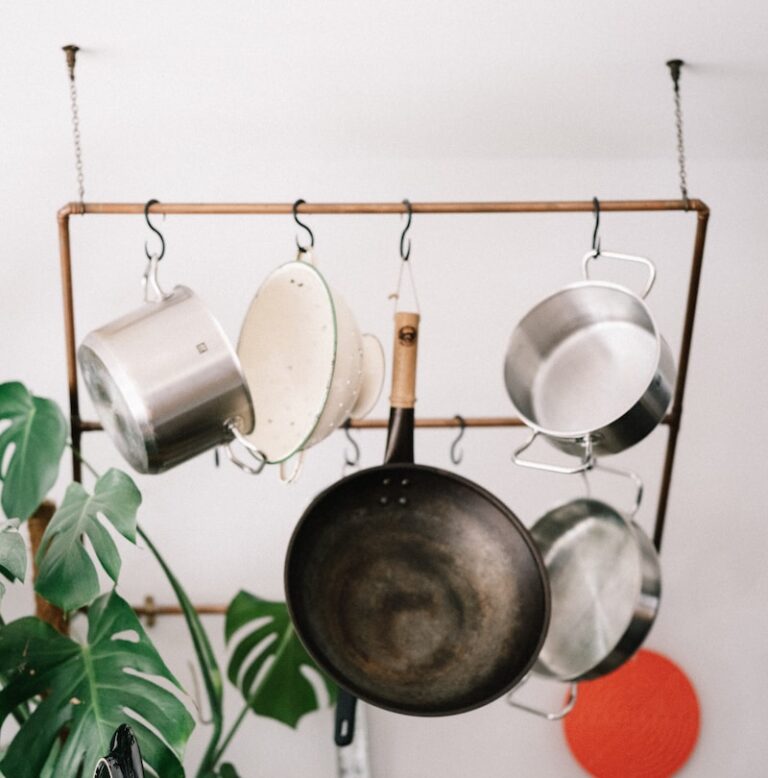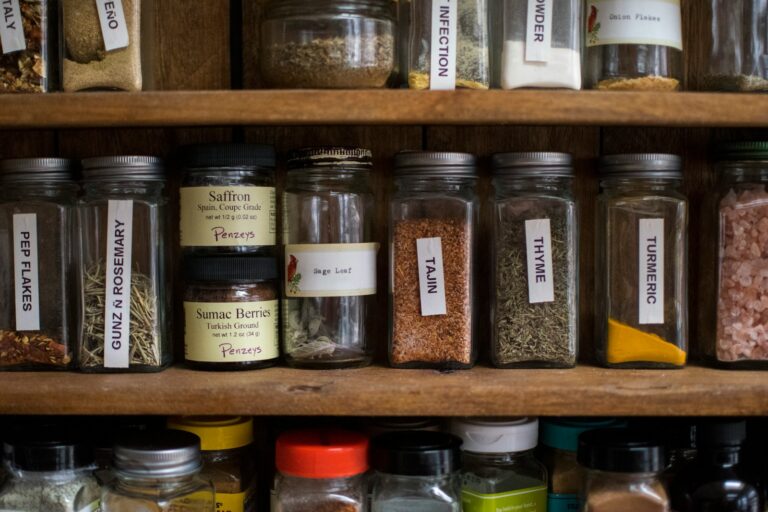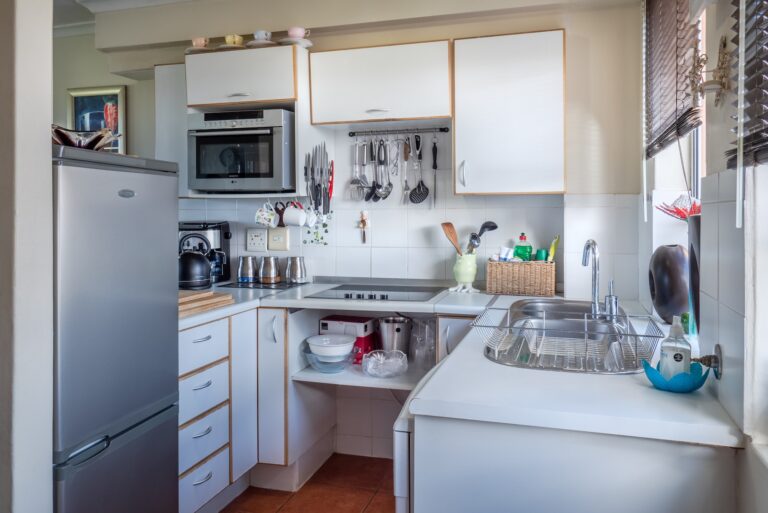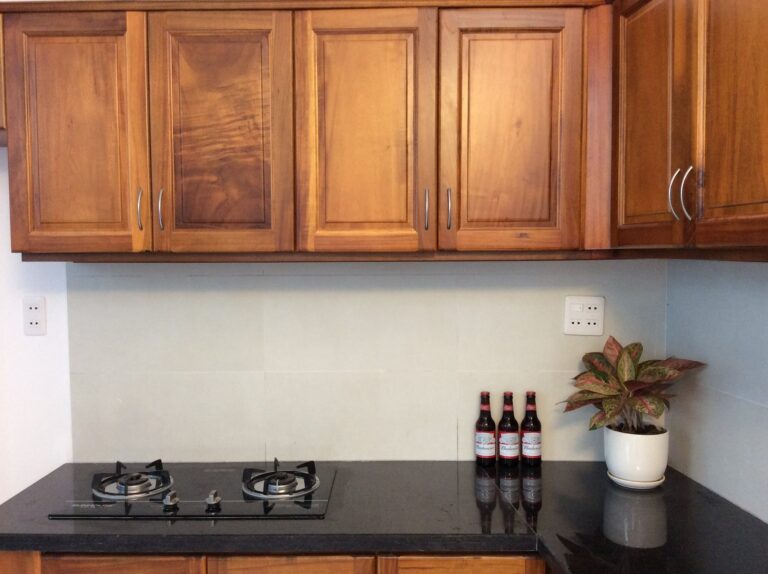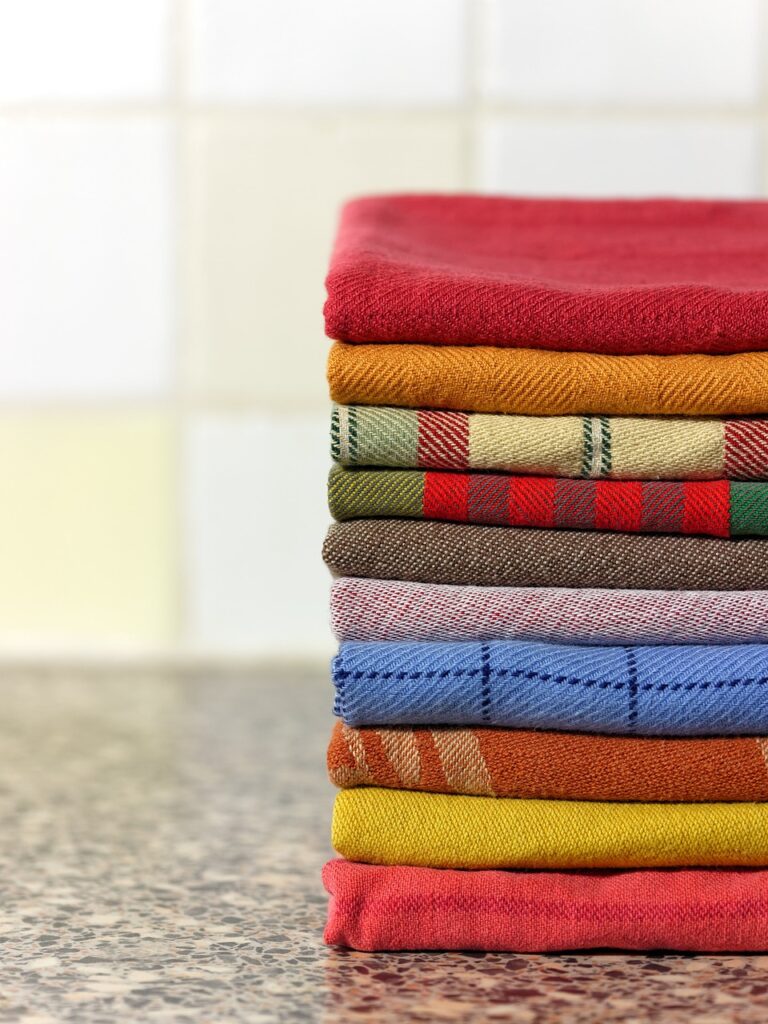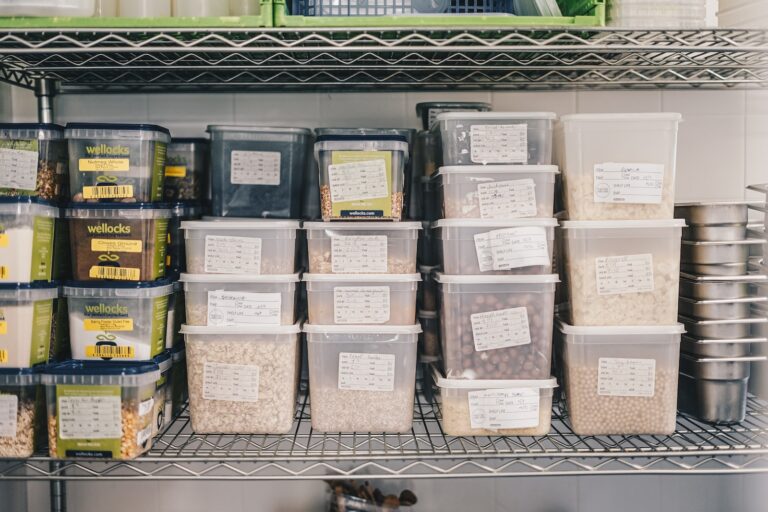Hey there! So you just moved into a brand new kitchen, huh? Well, congratulations! Now comes the fun part – getting it all spick and span.
But don’t fret, I’ve got you covered with some helpful tips to make your cleaning journey a breeze. From clearing countertops to deep cleaning appliances, I’ll walk you through it all.
So let’s roll up our sleeves and get that new kitchen shining!
Key Takeaways
- Gather all necessary cleaning supplies and organize cleaning tools before starting the cleaning process.
- Clear clutter from countertops and organize spices to create a clean and organized space.
- Remove detachable parts of appliances and clean them thoroughly using vinegar and water.
- Use proper wiping techniques with a microfiber cloth and mild cleaning solution to clean surfaces, and sweep and mop floors regularly to keep them clean and free from dirt.
Preparing Your Cleaning Supplies
I really need to quickly gather all my cleaning supplies to start tackling this mess.
The first thing I need to do is prepare my cleaning solutions. I grab my all-purpose cleaner, glass cleaner, and disinfectant spray. I also make sure to have some vinegar and baking soda on hand for those tough stains.
Once I’ve my cleaning solutions ready, I move on to organizing my cleaning tools. I gather my microfiber cloths, scrub brushes, and sponges. I also make sure to have a mop and bucket for the floors. I neatly arrange all my cleaning tools in a caddy for easy access.
With my cleaning supplies prepared and my tools organized, I’m ready to tackle this kitchen and make it sparkle again.
Clearing and Organizing Countertops
After clearing and organizing countertops, I can finally start cleaning the rest of the kitchen. It’s amazing how much clutter can accumulate on these surfaces. But by taking the time to clear it all away, I feel a sense of relief and accomplishment.
Now that everything is in its place, I can move on to the next step: organizing spices. This may seem like a small task, but it can make a big difference in the functionality of your kitchen. By organizing spices, you can easily find what you need when cooking and avoid buying duplicates. Plus, it adds a touch of organization and aesthetics to your kitchen.
Wiping Down Cabinets and Drawers
To ensure cleanliness, I’ll wipe down cabinets and drawers, as well as organizing their contents.
Cleaning techniques are essential to maintain a hygienic kitchen environment.
When it comes to wiping down cabinets and drawers, it’s important to use proper wiping techniques. I start by removing all the items from the cabinets and drawers, ensuring that each item is properly cleaned before putting them back.
Then, I use a microfiber cloth dampened with a mild cleaning solution to wipe the surfaces, making sure to reach into corners and crevices. It’s crucial to wipe in a gentle, circular motion to effectively remove any dirt or grime.
After wiping, I thoroughly dry the surfaces to prevent any moisture buildup.
Deep Cleaning Appliances
During my deep cleaning session, I’ll start by removing the detachable parts of the appliances and wiping them down with a mixture of vinegar and water, ensuring that every nook and cranny is thoroughly cleaned.
It’s important to keep our kitchen appliances clean for optimal performance and longevity.
When deep cleaning the oven, remember to remove the racks and soak them in warm, soapy water while you clean the interior.
For maintaining the dishwasher, it’s essential to regularly clean the filter and spray arms to prevent clogs and ensure proper water flow. Additionally, running a cycle with vinegar or dishwasher cleaner can help remove any built-up residue.
Scrubbing and Disinfecting the Sink
I’ll start by scrubbing and disinfecting the sink, making sure to remove any food particles and bacteria that may be lingering. When it comes to scrubbing techniques, I find that using a mixture of baking soda and water works wonders. I apply it to the sink and use a sponge or scrub brush to scrub away any stains or residue.
For tougher stains, I gently scrub with a soft-bristle brush, being careful not to scratch the surface. As for choosing the right disinfectant, I opt for a bleach-based solution or a commercial disinfectant that’s specifically designed for sinks and kitchen surfaces.
I ensure that the disinfectant is left on for the recommended time before rinsing thoroughly. By following these scrubbing techniques and choosing the right disinfectant, I can ensure that my sink is clean and free from harmful bacteria.
Cleaning and Maintaining Flooring
I sweep and mop the floors regularly to keep them free from dirt and grime. Maintaining clean and well-maintained flooring is essential for a hygienic and aesthetically pleasing home.
Here are some floor cleaning techniques and tips that I find effective:
- Use a microfiber mop or cloth to sweep and mop the floors. This helps to trap dust and dirt particles, preventing them from spreading around.
- Avoid using harsh chemicals or abrasive cleaners that can damage the flooring. Instead, opt for gentle and eco-friendly cleaning solutions.
- Mix vinegar and water for a homemade floor cleaner that’s safe and effective on most types of flooring.
- For stubborn stains, try using baking soda paste or hydrogen peroxide to lift and remove them gently.
Removing Grease and Stains From Walls
To remove grease and stains from walls, I use a mixture of warm water and dish soap. It’s a simple and effective method that doesn’t require any harsh chemicals. I fill a bucket with warm water and add a few drops of dish soap. Then, I dip a sponge or cloth into the mixture and gently scrub the affected area. The grease and stains usually come off easily, leaving the walls clean and fresh.
To prevent future stains, I make sure to wipe down the walls regularly, especially in areas prone to grease buildup such as the kitchen. I also use a grease-resistant paint or apply a protective coating to the walls. Additionally, I avoid cooking with excessive oil and use splatter guards to minimize grease splatters. By following these simple steps, I can keep my walls looking clean and grease-free.
Here is a table summarizing the grease removal techniques and preventing future stains:
| Grease Removal Techniques | Preventing Future Stains |
|---|---|
| Warm water and dish soap | Regular wall cleaning |
| Sponge or cloth | Grease-resistant paint |
| Gentle scrubbing | Protective coating |
| No harsh chemicals | Splatter guards |
Polishing Stainless Steel Surfaces
There are several methods for polishing stainless steel surfaces, such as using a combination of vinegar and olive oil or using a stainless steel cleaner and a microfiber cloth. Personally, I find the vinegar and olive oil method to be effective and budget-friendly.
It’s simple: just mix equal parts vinegar and olive oil, apply it to the surface with a cloth, and then buff it dry with a clean cloth. This combination not only removes fingerprints and smudges but also leaves a shiny finish.
However, when cleaning stainless steel appliances, it’s important to be cautious to prevent scratches. Here are some tips to consider:
- Always use a soft cloth or sponge when cleaning stainless steel surfaces.
- Avoid using abrasive cleaners or scrub brushes that can damage the surface.
- Wipe in the direction of the grain to avoid creating potential scratches.
Freshening Up the Fridge and Freezer
I always make sure to thoroughly clean my fridge and freezer at least once a month to keep them fresh and odor-free. Cleaning appliances is an essential part of maintaining a clean and hygienic kitchen. It not only helps to eliminate any unpleasant odors, but also ensures that our food stays fresh and safe to consume.
When it comes to organizing the fridge, I find it helpful to use a 3 column and 5 row table to keep things in order. Here’s a simple example:
| Column 1 | Column 2 | Column 3 |
|---|---|---|
| Top Shelf | Leftovers | Dairy Products |
| Middle Shelf | Beverages | Fresh Produce |
| Bottom Shelf | Condiments | Meat |
| Door | Sauces | Eggs |
| Freezer | Frozen Foods | Ice Cream |
Cleaning and Maintaining Kitchen Utensils
I always make sure to regularly clean and sanitize my kitchen utensils, using hot water and dish soap to remove any bacteria or food residue. It’s important to keep your kitchen utensils clean and well-maintained to ensure the safety of your food and prevent cross-contamination.
Here are some tips for cleaning and maintaining kitchen utensils:
- Cleaning:
- Wash utensils immediately after use to prevent food from drying and sticking.
- Use a scrub brush or sponge to remove any stubborn stains or residue.
- Proper storage:
- Store utensils in a clean and dry drawer or utensil holder to avoid dust and dirt accumulation.
- Keep sharp knives separate from other utensils to prevent accidents and maintain their sharpness.
Eliminating Odors and Keeping the Kitchen Fresh
To effectively eliminate odors and keep my kitchen fresh, I always make sure to regularly take out the trash and clean the refrigerator. These two simple tasks go a long way in preventing food spoilage and maintaining a pleasant kitchen environment.
When it comes to eliminating odors, I also find it helpful to use natural solutions like baking soda. I sprinkle a little bit in the trash can and in the refrigerator to absorb any unpleasant smells. Additionally, I make sure to clean up any spills or food crumbs immediately to prevent them from causing lingering odors.
Regularly airing out the kitchen by opening windows and using a ventilation fan also helps to keep the air fresh and free from any unwanted odors.
Establishing a Cleaning Routine for Long-Term Maintenance
When it comes to maintaining a clean kitchen in the long run, establishing a cleaning routine is key.
I find that cleaning on a regular basis not only keeps my kitchen looking tidy, but also helps prevent the buildup of dirt and grime.
Frequency of Cleaning
Keeping up with regular cleaning is essential for maintaining a clean and hygienic kitchen. When it comes to the frequency of cleaning, it’s important to find a balance that suits your lifestyle and keeps your kitchen in top shape.
Here are a few things to consider:
- Daily cleaning tasks:
- Wiping down countertops and surfaces
- Washing dishes and utensils
- Weekly cleaning tasks:
- Sweeping and mopping the floors
- Cleaning the refrigerator and microwave
Finding the best cleaning products for your kitchen is also crucial. Look for products that are effective in removing grease and grime without leaving behind harmful residues. Some popular options include multi-purpose cleaners, dish soaps, and disinfectant sprays. Experiment with different products to find what works best for you.
Essential Cleaning Supplies
I always make sure to have a variety of cleaning supplies on hand, such as disinfectant wipes and all-purpose cleaner, so that I can maintain a clean and healthy kitchen.
One important aspect of cleaning is preventing cross contamination, especially when handling raw meat or eggs. I find it helpful to use separate cutting boards and utensils for different types of food to avoid any potential contamination.
Additionally, I’ve recently been exploring eco-friendly cleaning options. It’s great to know that there are environmentally friendly cleaning products available that are just as effective as traditional ones. I’ve started using natural ingredients like vinegar and baking soda to clean surfaces and remove stains.
It’s not only beneficial for the environment but also for my family’s health.
Time-Saving Cleaning Techniques
To save time, I combine wiping down surfaces with dusting to efficiently clean my home. It’s a simple technique that allows me to tackle multiple cleaning tasks at once.
Here are a few more time-saving techniques and efficient cleaning methods that I use:
- Prioritize tasks: Start with the most important areas first, such as the kitchen and bathrooms, and then move on to less frequently used spaces.
- Multitask: While waiting for cleaning solutions to do their magic, I use that time to tidy up other areas or tackle small organizing tasks.
- Use the right tools: Invest in quality cleaning equipment that makes the job easier and more efficient, like microfiber cloths and a good vacuum cleaner with attachments.
- Create a cleaning schedule: By establishing a routine and sticking to it, I can stay on top of cleaning tasks and avoid them piling up.
Conclusion
Cleaning a new kitchen may seem like a daunting task, but with the right tips and a little effort, it can be easily accomplished.
By preparing your cleaning supplies, organizing countertops, and deep cleaning appliances, you can ensure that your kitchen stays fresh and clean.
Remember to establish a cleaning routine for long-term maintenance, and soon enough, your new kitchen will be sparkling and ready for use.


